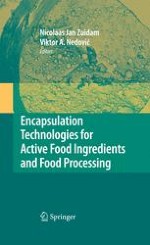2010 | OriginalPaper | Buchkapitel
9. Encapsulation of Enzymes and Peptides
verfasst von : Gabrie M. H. Meesters
Erschienen in: Encapsulation Technologies for Active Food Ingredients and Food Processing
Verlag: Springer New York
Aktivieren Sie unsere intelligente Suche, um passende Fachinhalte oder Patente zu finden.
Wählen Sie Textabschnitte aus um mit Künstlicher Intelligenz passenden Patente zu finden. powered by
Markieren Sie Textabschnitte, um KI-gestützt weitere passende Inhalte zu finden. powered by
